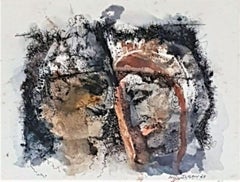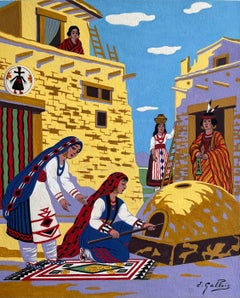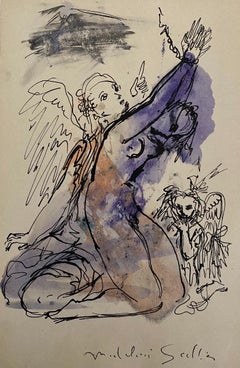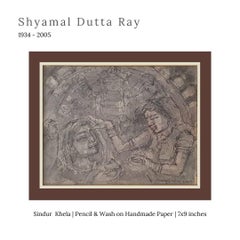Shyamal Dutta Ray Drawings and Watercolor Paintings
to
1
1
1
Overall Width
to
Overall Height
to
1
1
1
2
1
1
1
1
1
1
1
1
2
2
2
4
964
397
279
278
1
1
Artist: Shyamal Dutta Ray
Bride & Bridegroom, Watercolour on Paper by Modern Indian Artist "In Stock"
By Shyamal Dutta Ray
Located in Kolkata, West Bengal
Shyamal Dutta Ray - Untitled - 10 x 12 inches (unframed size)
Watercolour on Paper, 1994
Style : The poignant imagery in Shyamal Dutta Ray’s paintin...
Category
Early 2000s Modern Shyamal Dutta Ray Drawings and Watercolor Paintings
Materials
Paper, Watercolor
Bengali Woman: Browns, Grays, Reminiscent of Old Bengal by Modern Master Artist
By Shyamal Dutta Ray
Located in Kolkata, West Bengal
Shyamal Dutta Ray - 'Nostalgia' : A Stunning renidition of a old bengali woman in her bengali home with the bengali mirror metaphorically talking abo...
Category
1990s Modern Shyamal Dutta Ray Drawings and Watercolor Paintings
Materials
Paper, Watercolor
Related Items
French Gouache Painting of Pueblo Bread Baking in Taos New Mexico
Located in Cirencester, Gloucestershire
Title: French Gouache Painting of Pueblo Bread Baking in Taos New Mexico
by Emile GALLOIS (1882-1965, French)
Signed: Yes
Medium: Original gouache painting on thick unframed paper,
S...
Category
Mid-20th Century American Modern Shyamal Dutta Ray Drawings and Watercolor Paintings
Materials
Gouache
$510 Sale Price
30% Off
H 13.75 in W 11 in D 1 in
The Angels - Original China Ink and Watercolor by Madeleine Scellier - 1955
By Madeleine Scellier
Located in Roma, IT
The Angels is an original drawing in watercolored china ink on ivory-colored paper realized by the French artist Madeleine Scellier (1928).
Hand-signed in pencil on the lower margin...
Category
1950s Modern Shyamal Dutta Ray Drawings and Watercolor Paintings
Materials
Paper, Ink, Watercolor
$532
H 9.45 in W 6.3 in D 0.04 in
French Gouache Painting of Native American Antelope Hunt in Utah
Located in Cirencester, Gloucestershire
Title: French Gouache Painting of Native American Antelope Hunt in Utah
by Emile GALLOIS (1882-1965, French)
Signed: Yes
Medium: Original gouache painting on thick unframed paper,
Si...
Category
Mid-20th Century American Modern Shyamal Dutta Ray Drawings and Watercolor Paintings
Materials
Gouache
$491 Sale Price
30% Off
H 13.75 in W 11 in D 1 in
French Gouache Painting of Indigenous Council Gathering in Colorado Nevada
Located in Cirencester, Gloucestershire
Title: French Gouache Painting of Indigenous Council Gathering in Colorado Nevada
by Emile GALLOIS (1882-1965, French)
Signed: Yes
Medium: Original gouache painting on thick unframed...
Category
Mid-20th Century American Modern Shyamal Dutta Ray Drawings and Watercolor Paintings
Materials
Gouache
$496 Sale Price
30% Off
H 13.75 in W 11 in D 1 in
Indian Dancer - Vintage Illustration in Ink and Watercolor
By Irene Pattinson
Located in Soquel, CA
Indian Dancer - Vintage Illustration in Ink and Watercolor
A stoic, dark-haired woman in elaborate dress is sitting cross-legged in this illustration by Irene Pattinson (American, 1909-1999). Pattinson uses fine ink line detail and a vibrant pink watercolor for a splash of color.
Signed at the bottom, "Irene Pattinson."
Provenance: The Artist, Estate of Irene Pattinson: David Carlson; Estate of Larry Miller Fine Art, Robert Azensky Fine Art.
Presented in a new white mat with foam core backing.
Mat size: 16"H x 12"W
Paper size: 11.75"H x 8.5"W
Image size: 7.5"H x 6.5"W
Irene Pattinson (American, 1909-1999) studied at the California School of Fine Art (now The San Francisco Art Institute), San Francisco State College and The Marion Hartwell School of Design. She was President of the San Francisco Woman Artists Association 1955-56.
Provenance: The Artist, Estate of Irene Pattinson: David Carlson; Estate of Larry Miller Fine Art, Robert Azensky Fine Art.
Solo Exhibitions: Lucien Labaudt Gallery 1955; San Francisco Museum of Art, 1961 (39 works).
Selected Group Exhibitions: San Francisco Art Association Annual 1948, 54, 55; San Francisco Woman Artists, 1957-1960; Oakland Art Museum Annual, 1951, 58; California Palace of the Legion of Honor, 1960; Richmond Art Center, 1955, 56, 57, 58; San Francisco Art Institute 1959, 60. The Art Bank of the San Francisco Art Association, 1958, 59, 60, 62, 63; Winter Invitational, California Palace of The Legion of Honor, San Francisco, 1960; Fourth Winter Invitational, California Palace of The Legion of Honor, San Francisco, 1963.
Awards: First Place, San Francisco Woman Artists Assoc., 1957, 1959; San Francisco Art Festival 1957;Literature: San Francisco Art Institute - A catalog of the Art Ban 1962/63; San Francisco and the Second Wave: The Blair Collection
Exhibitions:
1963 The Art Bank of the San Francisco Art Association, San Francisco, CA
1963 California Palace of The Legion of Honor: Forth Winter Invitational, San Francisco, CA
1962 The Art Bank of the San Francisco Art Association, San Francisco, CA
1961 San Francisco Museum of Art, San Francisco, CA
1960 California...
Category
1950s American Modern Shyamal Dutta Ray Drawings and Watercolor Paintings
Materials
Paper, India Ink, Watercolor, Pen
$1,150
H 16 in W 12 in D 0.25 in
The Night Walk - Drawing attr. to Lucie Navier - Mid-20th Century
Located in Roma, IT
Ink, tempera, watercolor and white lead on brown paper attr. to Lucie Navier, and realized in the mid-20th Century.
Good condition excpet for some signs of age.
Category
Mid-20th Century Modern Shyamal Dutta Ray Drawings and Watercolor Paintings
Materials
Paper, Watercolor, Ink, Tempera
$567
H 15.75 in W 11.3 in D 0.04 in
French Gouache Painting of Navajo Night Dance in New Mexico
Located in Cirencester, Gloucestershire
Title: French Gouache Painting of Navajo Night Dance in New Mexico
by Emile GALLOIS (1882-1965, French)
Signed: Yes
Medium: Original gouache painting on thick unframed paper,
Size: 1...
Category
Mid-20th Century American Modern Shyamal Dutta Ray Drawings and Watercolor Paintings
Materials
Gouache
$510 Sale Price
30% Off
H 13.75 in W 11 in D 1 in
Chaim Gross Mid Century Mod Judaica Jewish Watercolor Painting Rabbis WPA Artist
By Chaim Gross
Located in Surfside, FL
Chaim Gross (American, 1904-1991)
Watercolor painting
Rabbinical Talmudic Discussion
Hand signed
17 x 29 framed, paper 10 x 22
Chaim Gross (March 17, 1904 – May 5, 1991) was an ...
Category
Mid-20th Century American Modern Shyamal Dutta Ray Drawings and Watercolor Paintings
Materials
Paper, Watercolor
$1,200
H 17 in W 29 in D 7 in
Chicago Jewish Modernist Judaica Painting Simchat Torah WPA Artist Israeli Flags
By Alexander Raymond Katz
Located in Surfside, FL
This has young ISraeli pioneers dancing with the flag as typical of works of the late British mandate Palestine era early state of Israel.
Genre: Modern
Subject: Figurative (stained glass style)
Medium: Mixed media gouache on paper
Hand signed lower left
Alexander Raymond Katz, Hungarian / American (1895 – 1974)
Alexander Raymond Katz was born in Kassa, Hungary, and came to the United States in 1909. He studied at the Art Institute of Chicago and the Chicago Academy of Fine Arts. In the late 1920s, he worked as a director of the Poster Department at Paramount Studios. He was appointed the Director of Posters for the Chicago Civic Opera in 1930.
During the Great Depression, notable architect Frank Lloyd Wright urged Katz to become a muralist. In 1933, he was commissioned to paint a mural for the Century of Progress exposition in Chicago. In 1936, he painted the mural History of the Immigrant for the Madison, Ill., post office. Katz’s works were included in various exhibitions and now are part of several museum collections, including those of the Art Institute of Chicago; Corcoran Gallery of Art, Washington, D.C.; and the Jewish Museum, New York. His murals, bas-reliefs and stained glass designs adorn more than 200 Jewish synagogues in the United States.
Katz and other Jewish artists in Chicago who expressed Jewish and Biblical themes were inspired by the artist Abel Pann (1883-1963). Pann, who is regarded as the leading painter of the Land of Israel, exhibited in the Art Institute of Chicago in 1920.
Early in his career, Katz began to explore the artistic possibilities inherent in the characters of the Hebrew alphabet. He developed aesthetic and philosophical interpretations of each letter and became the leading innovator and pioneer in the field of Hebraic art.
Katz applies this concept in the woodcut Moses and the Burning Bush. Hebrew letters appears in Moses’ head, his cane and inside the flame. The initial of Moses’ name crowns his head. The letter in the flame is the first letter of the name of God. A combination of images and Hebrew letters appeared commonly in illustrations of the scene Moses and the Burning Bush in the Haggadah, the book of Passover.
The symbolism of the burning bush corresponds to the motifs of A Gift to Biro-Bidjan. Among the fourteen participating artists were notable Chicago modernists Todros Geller, Mitchell Siporin...
Category
Mid-20th Century Modern Shyamal Dutta Ray Drawings and Watercolor Paintings
Materials
Paper, Gouache
Glassblowers WPA American Scene Mid- 20th Century Modern Figurative Workers 1932
By Harry Gottlieb
Located in New York, NY
Glassblowers WPA American Scene Mid- 20th Century Modern Figurative Workers. Dated and signed "32 Harry Gottlieb" lower right. Sight: 13 1/8" H x 18 1/4" W.
Harry Gottlieb, painter, screenprinter, educator, and lithographer, was born in Bucharest, Rumania. He emigrated to America in 1907, and his family settled in Minneapolis. From 1915 to 1917, Gottlieb attended the Minneapolis Institute of Arts. After a short stint as an illustrator for the U.S. Navy, Gottlieb moved to New York City; he became a scenic and costume designer for Eugene O"Neill's Provincetown Theater Group. He also studied at the Philadelphia Academy of Fine Arts and the National Academy of Design.
He was one of America's first Social Realist painters, influenced by that Robert Henri-led movement in New York City where Gottlieb settled in 1918. He was also a pioneer in screen printing, which he learned while working for the WPA. He married Eugenie Gershoy, and the couple joined the artist colony at Woodstock, New York. He lectured widely on art education.
In 1923, Gottlieb settled in Woodstock, New York and in 1931, spent a a year abroad studying under a Guggenheim Fellowship.
In 1935, he joined the Federal Art Project...
Category
1930s American Modern Shyamal Dutta Ray Drawings and Watercolor Paintings
Materials
Paper, Gouache
Harry GottliebGlassblowers WPA American Scene Mid- 20th Century Modern Figurative Workers 1932, 1932
$3,520 Sale Price
20% Off
H 21 in W 26 in D 2 in
African Mama - Vintage Illustration in Ink and Watercolor
By Irene Pattinson
Located in Soquel, CA
African Mama - Vintage Illustration in Ink and Watercolor
A charming illustration, by Irene Pattinson (American, 1909-1999), shows a woman with a...
Category
1950s American Modern Shyamal Dutta Ray Drawings and Watercolor Paintings
Materials
Paper, India Ink, Watercolor, Pen
$636 Sale Price
20% Off
H 13 in W 10 in D 0.25 in
Vibrant French Gouache Painting of Navajo Jewelry Makers in Albuquerque
Located in Cirencester, Gloucestershire
Title: Vibrant French Gouache Painting of Navajo Jewelry Makers in Albuquerque
by Emile GALLOIS (1882-1965, French)
Signed: Yes
Medium: Original gouache painting on thick unframed p...
Category
Mid-20th Century American Modern Shyamal Dutta Ray Drawings and Watercolor Paintings
Materials
Gouache
$463 Sale Price
30% Off
H 13.75 in W 11 in D 1 in
Previously Available Items
Durga Puja, Watercolor on Handmade paper, Brown, Modern Indian Artist "In Stock"
By Shyamal Dutta Ray
Located in Kolkata, West Bengal
Shyamal Dutta Ray - Untitled - 7 x 9 inches or 17.78 x 22.86 cm (unframed size)
Watercolor on Handmade paper
Signed (LR) in Bengali.
Style : The poi...
Category
Early 2000s Modern Shyamal Dutta Ray Drawings and Watercolor Paintings
Materials
Paper, Watercolor, Handmade Paper
Shyamal Dutta Ray drawings and watercolor paintings for sale on 1stDibs.
Find a wide variety of authentic Shyamal Dutta Ray drawings and watercolor paintings available for sale on 1stDibs. You can also browse by medium to find art by Shyamal Dutta Ray in paint, paper, watercolor and more. Much of the original work by this artist or collective was created during the 1990s and is mostly associated with the modern style. Not every interior allows for large Shyamal Dutta Ray drawings and watercolor paintings, so small editions measuring 20 inches across are available. Customers who are interested in this artist might also find the work of K.G. Subramanyan, Badri Narayan, and Sakti Burman. Shyamal Dutta Ray drawings and watercolor paintings prices can differ depending upon medium, time period and other attributes. On 1stDibs, the price for these items starts at $3,920 and tops out at $9,500, while the average work can sell for $6,710.



